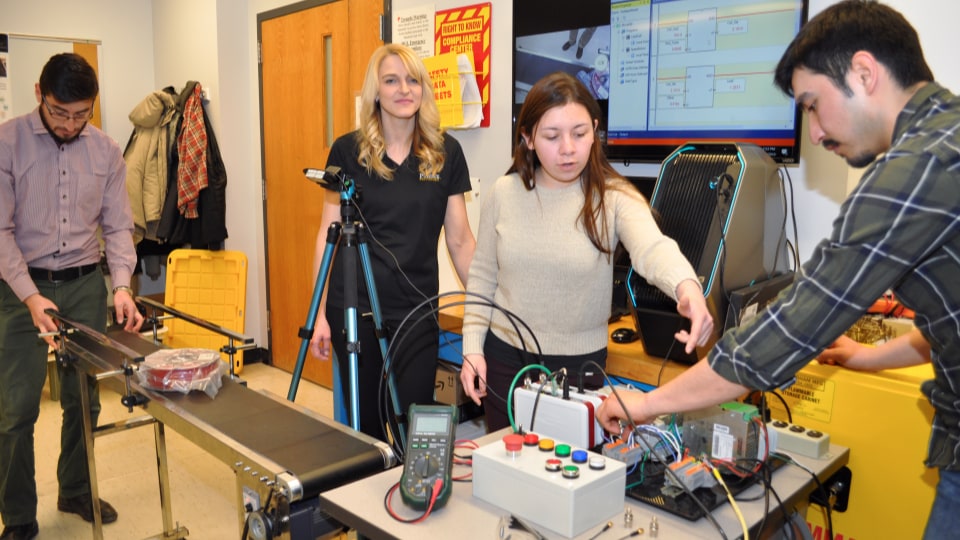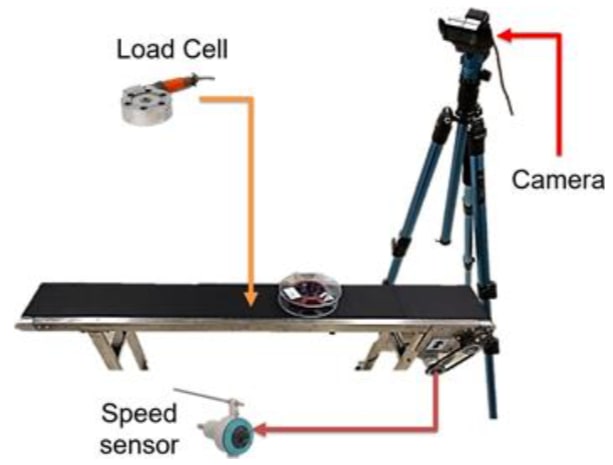
First used in coal mines and assembly lines in the early 20th century, conveyor belts are ubiquitous today. They move materials on manufacturing lines in factories, distribution lines in warehouses, material-handling lines in airports and post offices, and checkout lines at your local grocery store, among numerous other uses. Failure of the mechanical systems that comprise these conveyance systems can result in costly downtime in industry, so Purdue Polytechnic researchers studied how to use modern technology to keep the lines moving.
Jose Garcia Bravo and Brittany Newell, assistant professors of engineering technology, along with Jose Chamorro, a visiting undergraduate student, Santiago Guevara and Jose Solorio, graduate research assistants, and Laura Vallejo, a research assistant, collaborated to design a system that predicts the health of conveyance systems in industry. The research team also included Narciso Soto, an aeronautical engineering master’s student, and industry colleagues at InfoSys Limited and the Indiana Manufacturing Competitiveness Center (IN-MaC).
 Systems with the ability to communicate via the Internet of Things (IoT) have been embraced in many areas, the research team observed. For example, in agriculture and manufacturing, IoT usage affects cost, productivity and efficiency by decreasing production downtime.
Systems with the ability to communicate via the Internet of Things (IoT) have been embraced in many areas, the research team observed. For example, in agriculture and manufacturing, IoT usage affects cost, productivity and efficiency by decreasing production downtime.
Given the ubiquity of conveyor belts, the project team noted that adding IoT capabilities to these systems has the potential to improve efficiencies and reduce costs in a variety of industries.
Adding smarts to a conveyor system
Conveyor systems are affected by failure conditions that include belt rip, misalignment, tension issues, splice failure and obstruction by foreign objects. To design a system that could identify certain failure conditions, the research team installed a conveyor belt in Purdue Polytechnic’s Adaptive Additive Technologies Lab and set out to measure three key attributes: weight on the belt, alignment of the belt and speed of the belt.
- A load cell notes the weight of materials placed on the belt for transport.
- A camera observes the system’s operation and serves as an optical sensor to trace the alignment of the conveyor belt on the system of pulleys on which it moves.
- A speed sensor’s belt velocity data, recorded by directly coupling the sensor to the driving shaft of the conveyor belt, can be used to compute the rate at which material is being conveyed and detect belt slippage.
“The idea is to use the data from these sensors to predict failure,” said Garcia Bravo. “We want to correlate that information so that preventive maintenance can be scheduled before failure.”
Although the research team did not design the sensors, Garcia Bravo said the team created software that uses sensor data to determine if a conveyor belt is operating correctly. Their software also moves data to the cloud for remote monitoring of the system’s health.
“We spent a significant amount of time on the communication between each piece,” said Newell. “Sensors record a lot of data that needs to be sent to a programmable logic controller (PLC), filtered and changed, sent wirelessly to an IoT gateway and then into the cloud.”
Integrating project components and personnel expertise
Many sensor products are available on the market, but it took time to research which products would meet the team’s needs.
“It’s sometimes confusing,” Chamorro said. “A lot of products focus on IoT solutions, so we used metrics to try out different designs, select components and find the best solution.”
 Durability was an important consideration.
Durability was an important consideration.
“All the components we chose are industry grade, sturdier and more wear-resistant than those seen in a common research lab,” Garcia Bravo said. “But we used off-the-shelf components that weren’t necessarily meant to work together. The students have been very creative in adapting them into one single system.”
Members of the team brought different expertise to the research. Vallejo worked with Chamorro to study the metrics, learning which components were most suitable for the project. Vallejo also collaborated on integrating optical sensors, data acquisition and data processing using PLCs. Guevara focused on assembling the conveyor belt and the rotation devices that power it, and he also helped with final setup of the sensors.
Chamorro focused on system architecture — configuration of the various sensors, protocols needed to transmit data, and the like. “The software was required to be open-source,” he said, “so sometimes nobody was available to provide support. We had to adapt the open-source code, finding our own solutions to adapt it to our needs.”
Conveying more than the sum of its parts
Once the researchers designed the system and integrated its disparate components, every individual sensor sent data. The next step was to determine how recorded data could indicate potential failure of the conveyance system.
Image data from the vision system, for example, could analyze the edges of the conveyor belt to determine whether the belt’s alignment is within normal operating parameters. The research team developed a method to measure the distance between the center of the belt and the center of the structure. Misalignment of the belt can be expressed as a difference between the width of the belt-structure gap in pixels. When the belt-structure gap value changes beyond a normal operating variance, software could be programmed to alert operators of the potential need for maintenance.

“We needed to look at different types of failure to identify data that could be categorized as predictive,” said Newell. “We would like to integrate different types of sensors, including some that we’re designing in our own lab for integration into the belt itself.”
The research team hopes that their work will be applied in other settings. Garcia Bravo and Newell believe the technology could potentially be adapted for use in mobile equipment at construction sites and mines and in automotive applications, including autonomous vehicles.
